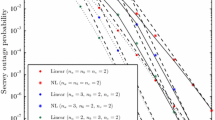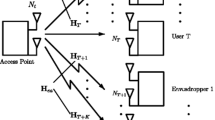Abstract
In this paper, physical layer security is investigated, which is characterized by utilizing the physical layer characteristics to achieve secure transmissions without adopting encryption or decryption. In order to acquire the secrecy capacity, we propose to employ the nonlinear transmission, where the operating point of the power amplifier is set to be relatively high, so that the transmitted signal displays obvious nonlinear property. At the receiver side, the legitimate user can carry out the nonlinear reception scheme utilizing the predesigned training information, which is unavailable for the wiretap channel. Consequently, the eavesdropper could hardly decode the messages correctly from the received nonlinearly distorted signal, leading to an effective enhancement of secrecy capacity. To validate the secrecy performance of this approach, nonlinearity cancellation algorithm is employed at the confidential receiver, while OFDM and single carrier systems are exploited in the simulations. Numerical results show that the proposed nonlinear transmission method has the capability in achieving the secrecy capacity for physical layer security.






Similar content being viewed by others
Data Availability
The datasets generated and/or analyzed during the current study are available from the corresponding author on reasonable request.
References
Solaija, M. S. J., Salman, H., & Arslan, H. (2022). Towards a unified framework for physical layer security in 5G and beyond networks. IEEE Open Journal of Vehicular Technology, 3, 321–343. https://doi.org/10.1109/OJVT.2022.3183218
Illi, E., et al. (2023). Physical layer security for authentication, confidentiality, and malicious node detection: A paradigm shift in securing IoT networks. IEEE Communications Surveys & Tutorials, 26(1), 347–388. https://doi.org/10.1109/COMST.2023.3327327
Jiang, X., Li, P., Zou, Y., Li, B., & Wang, R. (2022). Physical layer security for cognitive multiuser networks with hardware impairments and channel estimation errors. IEEE Transactions on Communications, 70(9), 6164–6180. https://doi.org/10.1109/TCOMM.2022.3194981
Yerrapragada, A. K., Eisman, T., & Kelley, B. (2021). Physical layer security for beyond 5G: Ultra secure low latency communications. IEEE Open Journal of the Communications Society, 2, 2232–2242. https://doi.org/10.1109/OJCOMS.2021.3105185
Soderi, S., & De Nicola, R. (2022). 6G networks physical layer security using RGB visible light communications. IEEE Access, 10, 5482–5496. https://doi.org/10.1109/ACCESS.2021.3139456
Zheng, T.-X., et al. (2022). Physical-layer security of uplink mmWave transmissions in cellular V2X networks. IEEE Transactions on Wireless Communications, 21(11), 9818–9833. https://doi.org/10.1109/TWC.2022.3179706
Liang, Y., Poor, H. V., & Shamai, S. (2009). Information theoretic security. Foundations and Trends® Communications and Information Theory, 5(4–5), 355–580.
Wang, D., Bai, B., Zhao, W., & Han, Z. (2019). A survey of optimization approaches for wireless physical layer security. IEEE Communications Surveys & Tutorials, 21(2), 1878–1911. https://doi.org/10.1109/COMST.2018.2883144
Zhang, W., Chen, J., Kuo, Y., & Zhou, Y. (2019). Artificial-noise-aided optimal beamforming in layered physical layer security. IEEE Communications Letters, 23(1), 72–75. https://doi.org/10.1109/LCOMM.2018.2881182
Arfaoui, M. A., Soltani, M. D., Tavakkolnia, I., Ghrayeb, A., Safari, M., Assi, C. M., & Haas, H. (2020). Physical layer security for visible light communication systems: a survey. IEEE Communications Surveys & Tutorials, 22(3), 1887–908. https://doi.org/10.1109/COMST.2020.2988615
Jung, H., & Lee, I. H. (2021). Distributed null-steering beamformer design for physical layer security enhancement in Internet-of-Things networks. IEEE Systems Journal, 15(1), 277–288. https://doi.org/10.1109/JSYST.2020.2967404
Schraml, M. G., Schwarz, R. T., & Knopp, A. (2021). Multiuser MIMO concept for physical layer security in multibeam satellite systems. IEEE Transactions on Information Forensics and Security, 16(1), 1670–1680. https://doi.org/10.1109/TIFS.2020.3040884
Gong, C., Yue, X., Zhang, Z., Wang, X., & Dai, X. (2021). Enhancing physical layer security with artificial noise in large-scale NOMA networks. IEEE Transactions on Vehicular Technology, 70(3), 2349–61. https://doi.org/10.1109/TVT.2021.3057661
Li, C., Liu, Y., Xu, Q., & Tang, Y. (2019). Self-interference cancellation with frequency offset and nonlinear distortion suppression for cooperative jamming communications. IEEE Communications Letters, 23(11), 2091–2094. https://doi.org/10.1109/LCOMM.2019.2936845
C. Li, W. Guo, X. Quan, Q. Xu, Y. Liu, Y. Shen, H. Zhao, and Y. Tang, "Nonlinear distortion suppression of cooperative jamming system for secure wireless communication," in 2019 IEEE MTT-S International Microwave Symposium (IMS), pp. 952–55, 2019, 978–1–7281–1309–8/19.
C. Li, X. **a, C. Shi, L. Du, J. Ma, Y. Liu, and Y. Tang, "Cooperative jamming cancellation under nonlinearity and imperfect time-frequency alignments for physical-layer security," in 2021 IEEE International Conference on Communications Workshops (ICC Workshops), 2021, 978–1–7281–9441–7/21.
Lee, K., Hong, J. P., Choi, H. H., & Quek, T. Q. S. (2019). Wireless-powered two-way relaying protocols for optimizing physical layer security. IEEE Transactions on Information Forensics and Security, 14(1), 162–174. https://doi.org/10.1109/TIFS.2018.2847452
Zhang, G., Xu, J., Wu, Q., Cui, M., Li, X., & Lin, F. (2018). Wireless powered cooperative jamming for secure OFDM system. IEEE Transactions on Vehicular Technology, 67(2), 1331–1346. https://doi.org/10.1109/TVT.2017.2756877
Belkacem, B. H., Ammari, O., & Bouallegue, M. L. (2017). Effect of power amplifier nonlinearity on the physical layer security of MIMO systems. Wireless Personal Communications, 96(10), 5587–5601. https://doi.org/10.1007/s11277-017-4429-3
Saeed, M., Moradikia, M., & Yeoh, P. (2020). Secure mm-Wave communications with imperfect hardware and uncertain eavesdropper location. Trans Emerg Telecommun Technol., 31(10), e4016. https://doi.org/10.1002/ett.4016
Güvenkaya, E., Hamamreh, J. M., & Arslan, H. (2017). On physical-layer concepts and metrics in secure signal transmission. Physical Communication, 25, 14–25. https://doi.org/10.1016/j.phycom.2017.08.011
Tellado, J., Hoo, L. M. C., & Cioffi, J. M. (2003). Maximum-likelihood detection of nonlinearly distorted multicarrier symbols by iterative decoding. IEEE Transactions on Communications, 51(2), 218–228. https://doi.org/10.1109/TCOMM.2003.809289
Alina, Z., & Amrani, O. (2016). On digital post-distortion techniques. IEEE Transactions on Signal Processing, 64(3), 603–614. https://doi.org/10.1109/TSP.2015.2477806
Csiszar, I., & Korner, J. (1978). Broadcast channels with confidential messages. IEEE Transactions on Information Theory, 24(3), 339–348. https://doi.org/10.1109/TIT.1978.1055892
Guo, Y., & Zhang, L. (2020). Secure full duplex OFDM wireless communication based on phase relay between the legitimate nodes. IET Communications, 14(8), 1293–1300. https://doi.org/10.1049/iet-com.2019.0916
Funding
The work was supported in part by the Natural Science Foundation of China under Grant 61941105, and in part by the Natural Science Foundation of Shaanxi Province under Grant 2019JM-532, and in part by China Postdoctoral Science Foundation under Grant 2017M623129, and also in part by Science and Technology on Underwater Information and Control Laboratory. (Corresponding author: Jieling Wang).
Author information
Authors and Affiliations
Corresponding author
Ethics declarations
Conflict of interest
The authors declare that they have no competing interests.
Additional information
Publisher's Note
Springer Nature remains neutral with regard to jurisdictional claims in published maps and institutional affiliations.
Rights and permissions
Springer Nature or its licensor (e.g. a society or other partner) holds exclusive rights to this article under a publishing agreement with the author(s) or other rightsholder(s); author self-archiving of the accepted manuscript version of this article is solely governed by the terms of such publishing agreement and applicable law.
About this article
Cite this article
Wang, J., Wang, Z., Sellathurai, M. et al. Secrecy Capacity Analysis Using Nonlinear Transmissions for Physical Layer Security. Wireless Pers Commun 136, 883–897 (2024). https://doi.org/10.1007/s11277-024-11294-x
Accepted:
Published:
Issue Date:
DOI: https://doi.org/10.1007/s11277-024-11294-x




